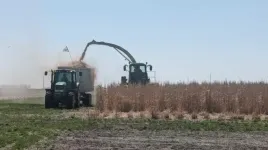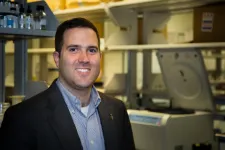(Press-News.org) It's easy to think that more nutrients -- the stuff life needs to grow and thrive -- would foster more vibrant ecosystems. Yet nutrient pollution has in fact wrought havoc on marine systems, contributing to harmful algae blooms, worse water quality and oxygen-poor dead zones.
A team of researchers from UC Santa Barbara has proposed a novel strategy for reducing large amounts of nutrients -- specifically nitrogen and phosphorous -- after they have already been released into the environment. In a study appearing in the journal Marine Policy, the authors contend that seaweed's incredible ability to draw nutrients from the water could provide an efficient and cost-effective solution. Looking at the U.S. Gulf of Mexico, the team identified over 63,000 square kilometers suitable for seaweed aquaculture.
"A key goal of conservation ecology is to understand and maintain the natural balance of ecosystems, because human activity tends to tip things out of balance," said co-author Darcy Bradley, co-director of the Ocean and Fisheries Program at the university's Environmental Markets Lab. Activities on land, like industrial-scale farming, send lots of nutrients into waterways where they accumulate and flow into the ocean in greater quantities than they naturally would.
Opportunistic algae and microbes take advantage of the glut of nutrients, which fuel massive blooms. This growth can have all kinds of consequences, from producing biotoxins to smothering habitats in virtual monocultures. And while these algae produce oxygen when they're alive, they die so suddenly and in such volume that their rapid decomposition consumes all the available oxygen in the water, transforming huge swaths of the ocean into so-called "dead zones."
Cultivated seaweed could draw down available nutrients, the authors claim, limiting the resources for unchecked growth of nuisance algae and microbes. Seaweeds also produce oxygen, which could alleviate the development of hypoxic dead zones.
The authors analyzed data from the U.S. Gulf of Mexico, which they say exemplifies the challenges associated with nutrient pollution. More than 800 watersheds across 32 states deliver nutrients to the Gulf, which has led to a growing low-oxygen dead zone. In 2019, this dead zone stretched just over 18,000 square kilometers, slightly smaller than the area of New Jersey.
Cortez grunt fish swim beneath a "red tide" algae bloom near the Bat Islands in Costa Rica's Santa Rosa National Park.
Cortez grunt fish swim beneath a "red tide" algae bloom near the Bat Islands in Costa Rica's Santa Rosa National Park. Blooms like these can release biotoxins and create oxygen-poor dead zones in the ocean.
Using open-source oceanographic and human-use data, the team identified areas of the gulf suitable for seaweed cultivation. They found roughly 9% of the United States' exclusive economic zone in the gulf could support seaweed aquaculture, particularly off the west coast of Florida.
"Cultivating seaweed in less than 1% of the U.S. Gulf of Mexico could potentially reach the country's pollution reduction goals that, for decades, have been difficult to achieve," said lead author Phoebe Racine, a Ph.D. candidate at UCSB's Bren School of Environmental Science & Management.
"Dealing with nutrient pollution is difficult and expensive," Bradley added. The U.S. alone spends more than $27 billion every year on wastewater treatment.
Many regions employ water quality trading programs to manage this issue. In these cap-and-trade systems regulators set a limit on the amount of a pollutant that can be released, and then entities trade credits in a market. Water quality trading programs exist all over the U.S., though they are often small, bespoke and can be ephemeral. That said, they show a lot of promise and, according to Racine, have bipartisan support.
Seaweed aquaculture would fit nicely within these initiatives. "Depending on farming costs and efficiency, seaweed aquaculture could be financed by water quality trading markets for anywhere between $2 and $70 per kilogram of nitrogen removed," Racine said, "which is within range of observed credit prices in existing markets."
What's more, the researchers note that demand is rising for seaweed in food and industry sectors. Potential products include biofuel, fertilizer and food, depending on the water quality, Racine said. This means that, unlike many remediation strategies, seaweed aquaculture could pay for itself or even generate revenue.
And the time seems ripe for the authors' proposal. "The U.S. has traditionally had a lot of barriers to getting aquaculture in the ocean," Bradley explained. "But there is mounting political support in the form of drafted bills and a signed executive order that could catalyze the expansion of the U.S. aquaculture industry."
This study is the first of several to come out of the Seaweed Working Group, an interdisciplinary group of researchers looking to understand and chart the potential of seaweed aquaculture's benefits to society. They are currently investigating a range of other ecosystem services that seaweed cultivation could provide, such as benefits to surrounding fisheries and carbon capture. The researchers are also working on a paper that explores nitrogen and phosphorous removal at the national level with fine-scale scale analysis modeling nutrient removal from native seaweeds off the coast of Florida.
As long as humans continue adding nutrients to the environment, nature will find ways to use them. By deliberately cultivating seaweeds, we can grow algae that we know are benign, helpful, or even potentially useful, rather than the opportunistic algae that currently draw upon these excess nutrients.
INFORMATION:
The discovery of a novel enzyme that releases a valuable chemical from agricultural waste could provide an important breakthrough in the upscaling of renewable fuels and chemicals, a new study shows.
Researchers - led by the University of York - have discovered an enzyme in a fungus which can act as a catalyst to bring about a biochemical reaction that breaks down lignocellulose
Lignocellulose is found in forestry and agricultural waste like wheat straw, which was used in this research. It has long been considered by scientists that this dry matter could ...
A team of engineering researchers at the Georgia Institute of Technology hopes to uncover new ways to diagnose and treat brain ailments, from tumors and stroke to Parkinson's disease, leveraging vibrations and ultrasound waves.
The five-year, $2 million National Science Foundation (NSF) project initiated in 2019 already has resulted in several published journal articles that offer promising new methods to focus ultrasound waves through the skull, which could lead to broader use of ultrasound imaging -- considered safer and less expensive than magnetic resonance imaging (MRI) technology.
Specifically, the team is researching a broad range of frequencies, spanning low frequency vibrations (audio frequency range) and moderate frequency guided waves (100 kHz to 1 MHz) to high ...
DALLAS (SMU) - An international team of paleontologists has identified a new genus and species of hadrosaur or duck-billed dinosaur, Yamatosaurus izanagii, on one of Japan's southern islands.
The fossilized discovery yields new information about hadrosaur migration, suggesting that the herbivors migrated from Asia to North America instead of vice versa. The discovery also illustrates an evolutionary step as the giant creatures evolved from walking upright to walking on all fours. Most of all, the discovery provides new information and asks new questions about dinosaurs in Japan.
The research, "A New Basal Hadrosaurid (Dinosauria: Ornithischia) From the latest Cretaceous Kita-ama Formation in Japan implies the origin of Hadrosaurids," ...
Researchers at the Pritzker School of Molecular Engineering (PME) at the University of Chicago have designed a completely novel potential treatment for COVID-19: nanoparticles that capture SARS-CoV-2 viruses within the body and then use the body's own immune system to destroy it.
These "Nanotraps" attract the virus by mimicking the target cells the virus infects. When the virus binds to the Nanotraps, the traps then sequester the virus from other cells and target it for destruction by the immune system.
In theory, these Nanotraps could also be used on variants of the virus, leading to a potential new way to inhibit the virus going forward. Though the therapy remains in early stages of testing, the researchers envision it could be administered ...
In a paper published in the journal Scientific Reports, researchers from Surrey investigated whether the daily consumption of a prebiotic food supplement could improve overall wellbeing in a group of 18 to 25 year-olds. The study found that those who received a daily dose of prebiotics improved mental wellbeing by reducing anxiety levels and had better gut health than the control group.
Researchers studied a group of 64 healthy female participants with no current or previous clinical diagnoses of anxiety. Participants received either a daily dose of the prebiotic galacto-oligosaccharides (GOS) or a placebo for 28 days.
All those involved in the trial completed surveys about their health experiences, including mood, anxiety and sleep quality and provided a stool sample ...
New studies from the Center for Advanced Bioenergy and Bioproducts Innovation (CABBI) shed more light on the economic and environmental costs of mandates in the Renewable Fuels Standard (RFS), a federal program to expand the nation's biofuels sector.
Researchers said the studies indicate the need to adopt more targeted policies that value the environmental and ecosystem benefits of perennial bioenergy crops over cheaper options -- and provide financial incentives for farmers to grow them.
The RFS was issued in 2005 and updated through the Energy Independence and Security Act of 2007 ...
MEMPHIS, Tenn. - For the first time in published literature, Le Bonheur Children's Hospital and University of Tennessee Health Science Center (UTHSC) researchers showed that a variety of white blood cells known as eosinophils modify the respiratory barrier during influenza A (IAV) infection, according to a recent paper in the journal Cells. This research could have implications in understanding SARS-CoV-2 (COVID-19) infection in asthmatic patients.
The Le Bonheur/UTHSC study found that eosinophils immunomodulate airway epithelial cells during IAV infection, helping to neutralize the virus and ...
The legend of the "kraken" has captivated humans for millennia. Stories of deep-sea squid dragging sailors and even entire ships to their doom can be found in everything from ancient Greek mythology to modern-day movie blockbusters. It is therefore ironic that the species that inspired these stories, the giant squid Architeuthis dux, is camera-shy. In fact, filming this species in the wild has proven an insurmountable challenge for countless scientists, explorers, and filmmakers. To date, only one scientist, Dr. Edith Widder of the Ocean Research & Conservation Association, has repeatedly caught a live giant squid on camera. In a new study, Dr. Widder and her colleagues have finally revealed the secrets behind their success. This study, which is free to access, also ...
An Academic Analytics Research Center (AARC) study published in the journal Scientometrics found that senior faculty (scholars who earned their terminal degree 30 or more years ago) research publication activity exceeded expectations based on age cohort population for book chapters and book publications, and senior scholars largely kept pace in terms of journal article publications. "Across all disciplines, senior faculty may be uniquely positioned to invest their time in a longer-term publication effort, shifting their research focus to the review and synthesis of ideas through the publication of books and chapters," said AARC Senior Researcher and Co-Author of the study, Bill Savage, Ph.D.
The study explored the publishing activity of 167,299 unique faculty members at American ...
Aromatics are major building blocks of polymers, or plastics, that turn up as everything from PET bottles for water to breathable, wrinkle-resistant polyester clothing. These petrochemicals comprise a specialized, value-added sector of the energy industry. The process for refining crude oil into useful aromatic streams for derivative use often involves the usage of a catalyst to facilitate chemical reactions. Among the various types of catalysts, many are zeolites - porous aluminosilicates - such as ZSM-5, a unique synthetic zeolite prolifically used in the upgrading of chemicals in alkylation and isomerization. Petrochemicals producers are constantly looking to minimize overhead costs to weather the volatility in commodity markets and provide a competitive end product ...




